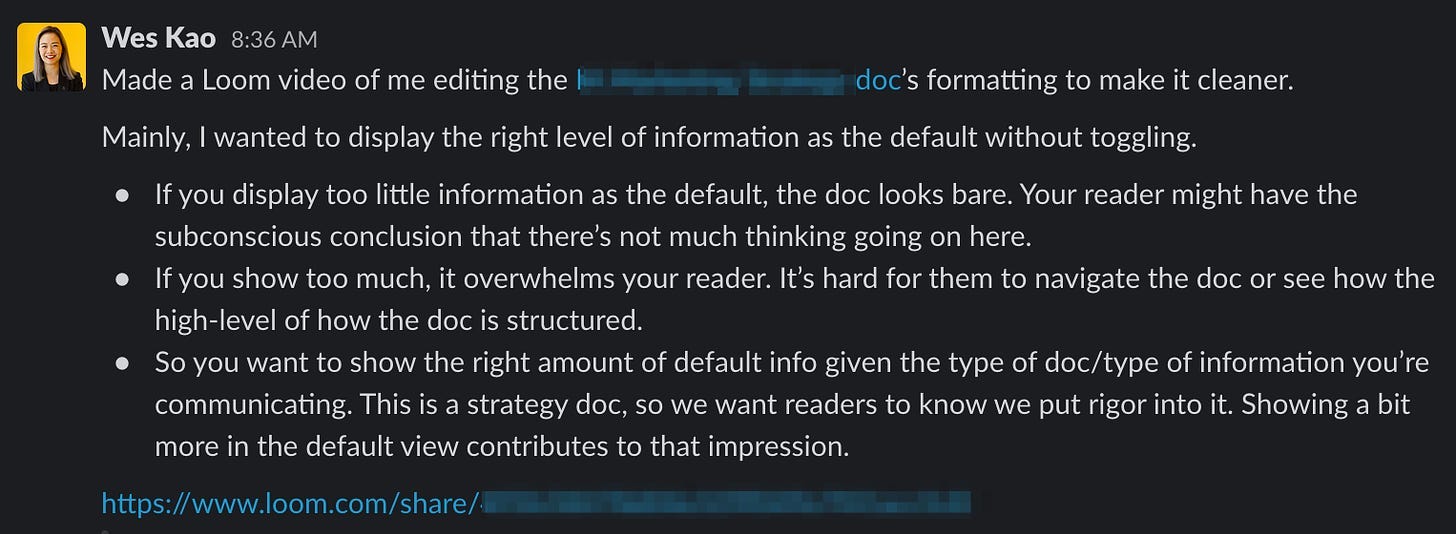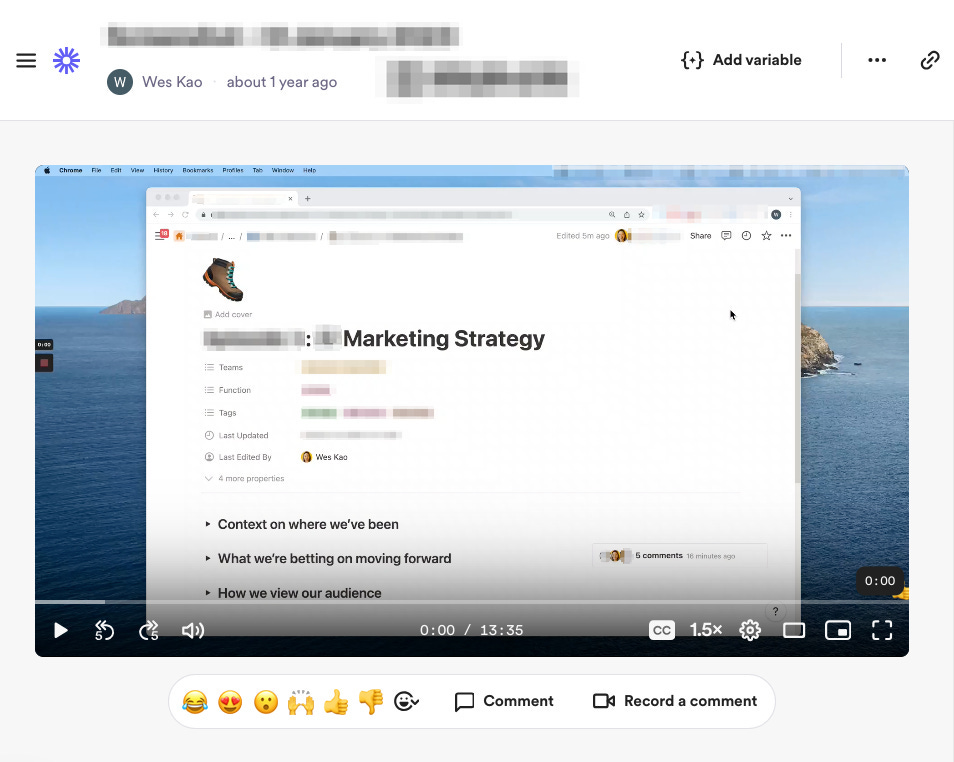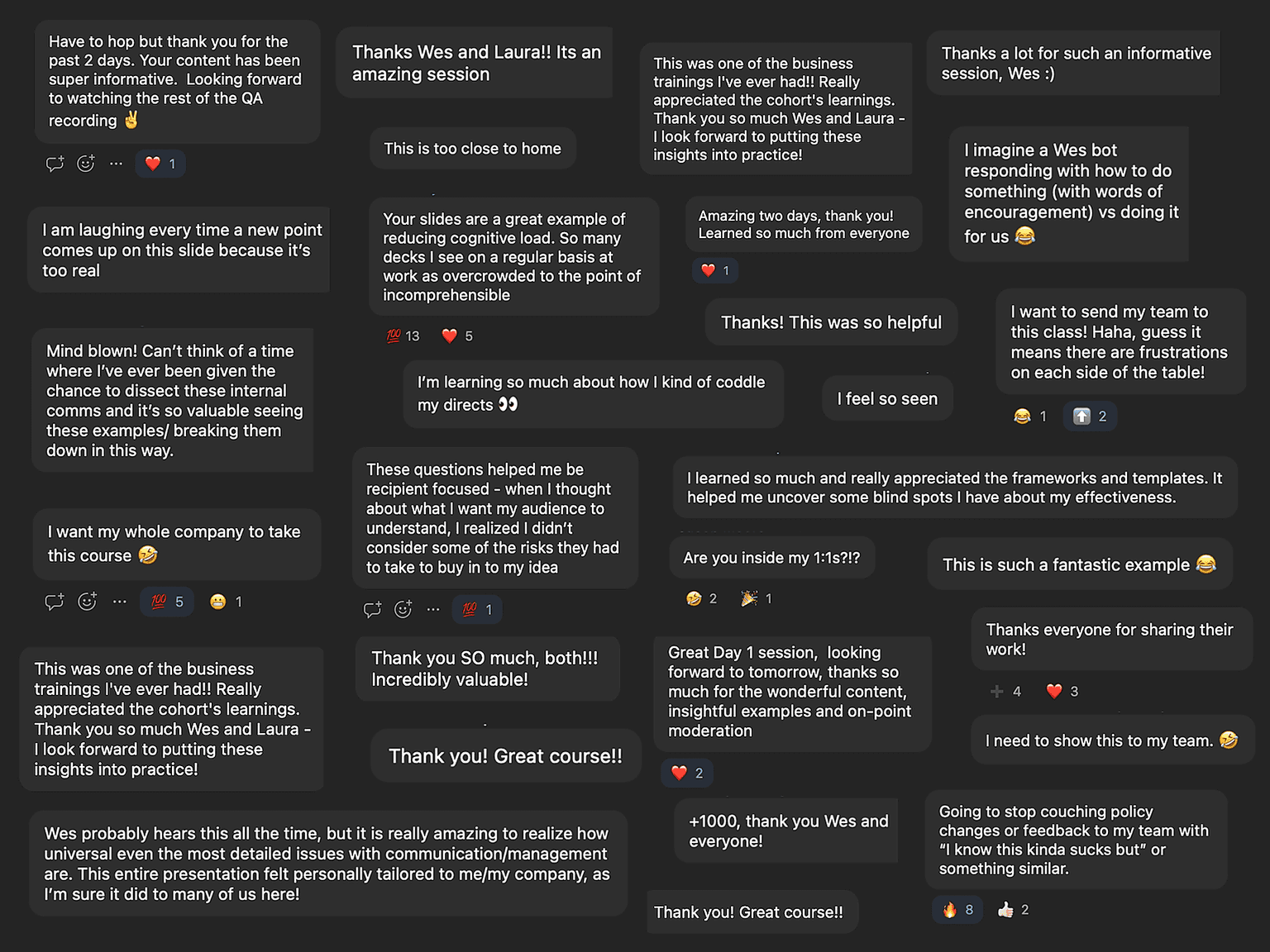How I give high-quality feedback quickly
How I give high-quality feedback quicklyIf you're not regularly giving feedback, you're missing a chance to scale your judgment. Here's how to give useful feedback in as little as 1-2 hours per week.👋 Hey, it’s Wes. Welcome to my weekly newsletter on managing up, leading teams, and standing out as a higher performer. For more, check out my intensive course on Executive Communication & Influence. Read time: 5 minutes Today's newsletter is sponsored by Uptempo. New year, new marketing plans. But even strong plans can fall apart due to competing priorities and shiny trends. The Blueprint for Marketing Planning helps you cut through the noise, focus on true growth drivers, and build a roadmap that delivers. Download the guide. Most leaders know sharing feedback is extremely high ROI, but there’s one problem: Time. I often hear clients ask, “Is there a way to give feedback that's relatively fast? How do I start?” Luckily, yes. You can give high-quality AND fast feedback in as little as 1-2 hours per week, and the results will compound. When I say “feedback,” I say this broadly to include: evaluating assets, shaping decisions, explaining your thought process behind a strategy, being a thought partner, critiquing write-ups, improving positioning, editing content, tightening a proposal, improving product flows, etc. When done thoughtfully, this investment scales your judgment across the organization. You teach your team to notice what you notice. As a founder, I chose to invest heavily in feedback—about 15 hours per week, which comes out to 3 hours/day. This meant my team needed less guidance over time, they felt energized from getting real feedback (vs an automatic “looks good to me”)—which allowed us to be a scrappy team that punched above our weight class. But you don’t need to be extreme to see results. The principles below will work even if you only have 1 hour per week. Here are four ways to make your feedback both high-quality AND fast.
1. Give feedback on one thing that will make the biggest difference.Give feedback on the 20% of work output that will make the biggest impact.
This teaches your team the skill of pattern matching. You’re not spelling everything out for them—you’re giving them a chance to practice applying what you just shared. Instead of fixing the whole document, you’re saving yourself time AND teaching them how to fish. When they level up the document, they’ll bring you a stronger version. Then you can mention the next most highly-leveraged piece of feedback, or pivot into giving line edits. 2. Don’t jump straight into line edits.If what you get is drastically different from what you expected, give structural feedback first. Here’s why: if you start with line edits, you might trim entire paragraphs later—so your line edits are wasted. Take a step back to see if the underlying premise and strategy itself might be off-base. Start with foundational questions like, Should we be doing this at all? Should we do it in this way? Of all the things we could do, why should we do this? Once your direct report sends back a revised version with the right strategy, then you can give line edits. Here are examples of structural feedback:
Another example:
Notice how I didn't give line edits. I gave one round of high-level feedback first, which can take as little as 5 minutes. This is better for me because it saves time. It’s better for my direct report because they get the right level of feedback at the right time. 3. You don’t need to write out all your feedback.Giving written feedback is giving feedback on hard mode. It might take 30 minutes to write coherently what you can say in 3 minutes out loud. The benefit of written feedback is it's highly scalable. But the downside is it takes time to write well, and realistically, you might not have that bandwidth. Don’t let that stop you from giving feedback. You have a variety of tools at your disposal: voice notes, Looms, phone calls, etc. Not everything needs to be written in order to be useful for your recipient. Fun fact: many Maven employees are in the top 10-15% of Loom users. One employee is in the top 3% of Loom users. We have an intentionally asynchronous company culture, so tools like this are super helpful for sharing high-fidelity feedback while allowing recipients to review when it's convenient for them. Loom is most useful for anything with a visual component. You're walking someone through what you see on your screen and adding voiceover. You can pull on more levers (tone of voice, visuals, pointing with your mouse) that help to convey meaning. To be clear, this does not mean you should give vague verbal feedback while sharing your screen. While there's more leeway for feedback that’s less tight than written feedback, you should still aim to give feedback that's TACS—tactical, actionable, concrete, and specific—even if you're doing it verbally. 4. Balance what’s easy for you (feedback giver) and easy for them (feedback receiver).You want to make feedback easy for your recipient to take action on, but you also need to do it in a way that doesn’t burn yourself out. Your direct reports would rather have you give feedback in the format you prefer than not get any at all. So above all, keep the process sustainable, so you can do it long enough to see your effort come to fruition. Which of these techniques are you most excited to try? Hit reply because I’d love to hear from you. Thanks for being here, and I’ll see you next Wednesday at 8am ET. Wes Course: Executive Communication & Influence for Senior Managers and ICsThe April 2025 cohort is open for enrollment. The course dates are April 10 & 11 from 12-3:30pm ET. As of today, the course is 55% full. In the past week, operators from Amazon, Google, Microsoft, OfferUp, First Round Capital, and more have enrolled. If you miss the April cohort, the next time I’m running the course will be summer 2025. → If you’d like to join us in April, here are the course details. Connect with Wes
|
Older messages
“Looks good to me” is a lazy default: Why managers should give feedback on work output
Wednesday, January 8, 2025
If you're not regularly giving feedback on work product, you're missing a valuable opportunity to invest in your team and set a higher bar. ͏ ͏ ͏ ͏ ͏ ͏ ͏ ͏ ͏ ͏ ͏ ͏ ͏ ͏ ͏ ͏ ͏ ͏ ͏ ͏ ͏ ͏ ͏ ͏ ͏ ͏ ͏
My top 9 articles to raise the bar for yourself and your team
Wednesday, December 11, 2024
Plus, a holiday break for my newsletter and a new cohort announcement ͏ ͏ ͏ ͏ ͏ ͏ ͏ ͏ ͏ ͏ ͏ ͏ ͏ ͏ ͏ ͏ ͏ ͏ ͏ ͏ ͏ ͏ ͏ ͏ ͏ ͏ ͏ ͏ ͏ ͏ ͏ ͏ ͏ ͏ ͏ ͏ ͏ ͏ ͏ ͏ ͏ ͏ ͏ ͏ ͏ ͏ ͏ ͏ ͏ ͏ ͏ ͏ ͏ ͏ ͏ ͏ ͏ ͏ ͏ ͏ ͏ ͏ ͏ ͏ ͏ ͏
How to write your own job description (and invent your role)
Tuesday, December 10, 2024
Many operators have either officially or unofficially written their own job description, and are reaping the benefits. Here's how you can get in on the fun. ͏ ͏ ͏ ͏ ͏ ͏ ͏ ͏ ͏ ͏ ͏ ͏ ͏ ͏ ͏ ͏ ͏ ͏ ͏ ͏
Wes Kao's Newsletter Holiday Gift Guide 2024
Wednesday, November 27, 2024
Gift ideas for the operators, leaders, and builders in your life (including yourself) ͏ ͏ ͏ ͏ ͏ ͏ ͏ ͏ ͏ ͏ ͏ ͏ ͏ ͏ ͏ ͏ ͏ ͏ ͏ ͏ ͏ ͏ ͏ ͏ ͏ ͏ ͏ ͏ ͏ ͏ ͏ ͏ ͏ ͏ ͏ ͏ ͏ ͏ ͏ ͏ ͏ ͏ ͏ ͏ ͏ ͏ ͏ ͏ ͏ ͏ ͏ ͏ ͏ ͏ ͏ ͏ ͏ ͏
How to give a senior leader feedback (without getting fired)
Wednesday, November 20, 2024
There's a right and wrong way to proceed. Here's how to increase the chances your leader listens and takes action--while reducing the chance they feel threatened. ͏ ͏ ͏ ͏ ͏ ͏ ͏ ͏ ͏ ͏ ͏ ͏ ͏ ͏ ͏
You Might Also Like
📂 How one startup gets PAID to acquire customers
Thursday, February 27, 2025
Turning government funding into a growth engine. ͏ ͏ ͏ ͏ ͏ ͏ ͏ ͏ ͏ ͏ ͏ ͏ ͏ ͏ ͏ ͏ ͏ ͏ ͏ ͏ ͏ ͏ ͏ ͏ ͏ ͏ ͏ ͏ ͏ ͏ ͏ ͏ ͏ ͏ ͏ ͏ ͏ ͏ ͏ ͏ ͏ ͏ ͏ ͏ ͏ ͏ ͏ ͏ ͏ ͏ ͏ ͏ ͏ ͏ ͏ ͏ ͏ ͏ ͏ ͏ ͏ ͏ ͏ ͏ ͏ ͏ ͏ ͏ ͏ ͏ ͏ ͏ ͏ ͏ ͏ ͏
Growth Newsletter #242
Thursday, February 27, 2025
Grow by stacking S-Curves ͏ ͏ ͏ ͏ ͏ ͏ ͏ ͏ ͏ ͏ ͏ ͏ ͏ ͏ ͏ ͏ ͏ ͏ ͏ ͏ ͏ ͏ ͏ ͏ ͏ ͏ ͏ ͏ ͏ ͏ ͏ ͏ ͏ ͏ ͏ ͏ ͏ ͏ ͏ ͏ ͏ ͏ ͏ ͏ ͏ ͏ ͏ ͏ ͏ ͏ ͏ ͏ ͏ ͏ ͏ ͏ ͏ ͏ ͏ ͏ ͏ ͏ ͏ ͏ ͏ ͏ ͏ ͏ ͏ ͏ ͏ ͏ ͏ ͏ ͏ ͏ ͏ ͏ ͏ ͏ ͏ ͏ ͏ ͏ ͏ ͏ ͏ ͏
18 Silicon Valley Startups Raised $851.1 Million - Week of February 10, 2025
Thursday, February 27, 2025
💕 Stanford HAI's First Open Virtual Assistant Workshop 💰 Top 10 Sovereign-Wealth Funds 👴🏼 Interview with Morris Chang 🤖 $16K Unitree G1 Robot 💡 Cathie Wood's Big Ideas 2025 Report ͏ ͏ ͏ ͏ ͏ ͏ ͏
For SaaS founders 👉
Thursday, February 27, 2025
Featuring recent software deals and how they happened ͏ ͏ ͏ ͏ ͏ ͏ ͏ ͏ ͏ ͏ ͏ ͏ ͏ ͏ ͏ ͏ ͏ ͏ ͏ ͏ ͏ ͏ ͏ ͏ ͏ ͏ ͏ ͏ ͏ ͏ ͏ ͏ ͏ ͏ ͏ ͏ ͏ ͏ ͏ ͏ ͏ ͏ ͏ ͏ ͏ ͏ ͏ ͏ ͏ ͏ ͏ ͏ ͏ ͏ ͏ ͏ ͏ ͏ ͏ ͏ ͏ ͏ ͏ ͏ ͏ ͏ ͏ ͏ ͏ ͏ ͏ ͏ ͏ ͏
🦄 Unicorner presents: DeepCorner
Thursday, February 27, 2025
Welcome to Unicorner's deep dive into DeepTech.
Sea Shacks And an Immoral Ghost 🌊
Thursday, February 27, 2025
And the no algorithm app͏ ͏ ͏ ͏ ͏ ͏ ͏ ͏ ͏ ͏ ͏ ͏ ͏ ͏ ͏ ͏ ͏ ͏ ͏ ͏ ͏ ͏ ͏ ͏ ͏ ͏ ͏ ͏ ͏ ͏ ͏ ͏ ͏ ͏ ͏ ͏ ͏ ͏ ͏ ͏ ͏ ͏ ͏ ͏ ͏ ͏ ͏ ͏ ͏ ͏ ͏ ͏ ͏ ͏ ͏ ͏ ͏ ͏ ͏
How X built the best fact-checking system on the internet | Keith Coleman (VP of Product) and Jay Baxter (ML Lead)
Thursday, February 27, 2025
Listen now (108 mins) | Inside Elon's favorite product feature: The story of X's Community Notes ͏ ͏ ͏ ͏ ͏ ͏ ͏ ͏ ͏ ͏ ͏ ͏ ͏ ͏ ͏ ͏ ͏ ͏ ͏ ͏ ͏ ͏ ͏ ͏ ͏ ͏ ͏ ͏ ͏ ͏ ͏ ͏ ͏ ͏ ͏ ͏ ͏ ͏ ͏ ͏ ͏ ͏ ͏ ͏ ͏ ͏ ͏ ͏
Make an offer is live
Thursday, February 27, 2025
You can now make offers and acquire startups safely on Microns. ͏ ͏ ͏ ͏ ͏ ͏ ͏ ͏ ͏ ͏ ͏ ͏ ͏ ͏ ͏ ͏ ͏ ͏ ͏ ͏ ͏ ͏ ͏ ͏ ͏ ͏ ͏ ͏ ͏ ͏ ͏ ͏ ͏ ͏ ͏ ͏ ͏ ͏ ͏ ͏ ͏ ͏ ͏ ͏ ͏ ͏ ͏ ͏ ͏ ͏ ͏ ͏ ͏ ͏ ͏ ͏ ͏ ͏ ͏ ͏ ͏ ͏ ͏ ͏ ͏ ͏ ͏ ͏ ͏
re: your private offer
Thursday, February 27, 2025
ends in a few hours. ͏ ͏ ͏ ͏ ͏ ͏ ͏ ͏ ͏ ͏ ͏ ͏ ͏ ͏ ͏ ͏ ͏ ͏ ͏ ͏ ͏ ͏ ͏ ͏ ͏ ͏ ͏ ͏ ͏ ͏ ͏ ͏ ͏ ͏ ͏ ͏ ͏ ͏ ͏ ͏ ͏ ͏ ͏ ͏ ͏ ͏ ͏ ͏ ͏ ͏ ͏ ͏ ͏ ͏ ͏ ͏ ͏ ͏ ͏ ͏ ͏ ͏ ͏ ͏ ͏ ͏ ͏ ͏ ͏ ͏ ͏ ͏ ͏ ͏ ͏ ͏ ͏ ͏ ͏ ͏ ͏ ͏ ͏ ͏ ͏ ͏ ͏ ͏ ͏ ͏
H cofounder takes top Meta job
Thursday, February 27, 2025
+ 14 wealthtech startups to watch; AI chips briefing View in browser Vanta_flagship Good morning there, Chips: great on a plate, even better in a supercomputer. Everyone's hungry for these tiny


